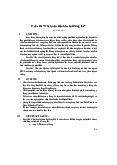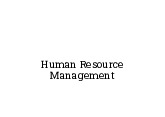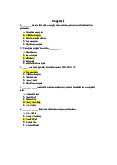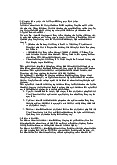





Preview text:
Journal of Cardiac Failure Vol. 17 No. 10 2011 Review Articles
Alcoholic Cardiomyopathy: A Review
ANIL GEORGE, MD,1 AND VINCENT M. FIGUEREDO, MD1,2 Philadelphia, Pennsylvania ABSTRACT
Alcohol abuse can cause cardiomyopathy indistinguishable from other types of dilated nonischemic car-
diomyopathy. Most heavy drinkers remain asymptomatic in the earlier stages of disease progression, and
many never develop the familiar clinical manifestations that typify heart failure. We review the current
thinking on the pathophysiology, clinical characteristics, and treatments available for alcoholic cardiomy-
opathy. The relationship of alcohol to heart disease is complicated by the fact that in moderation, alcohol
has been shown to afford a certain degree of protection against cardiovascular disease. (J Cardiac Fail 2011;17:844e849)
Key Words: Cardiomyopathy, alcohol, heart failure, systolic dysfunction, diastolic dysfunction.
Alcoholic cardiomyopathy (International Classification
alcohol use is the third leading lifestyle-related cause of
of Diseases, 10th ed: 142.6) as a unique disease entity
death for people in the USA each year, behind tobacco
has been familiar to physicians for almost 2 centuries.
and improper diet/lack of physical activity, which are
William Mackenzie is credited for having coined the term ranked 1 and 2, respectively.6
‘‘alcoholic heart disease’’ in his treatise Study of the Pulse
Yet a meta-analysis of 34 prospective studies comprising
in 1902.1 There exist in most societies and religions taboos
O1 million subjects and 10,000 deaths revealed a J-shaped
and proscriptions regarding the use and abuse of alcohol.
relationship between alcohol and total mortality, as shown
Nevertheless, references to ill effects from excess alcohol
in Fig. 1.7 Although alcohol consumed in moderation
usage abound in most societies. Examples include the ‘‘Tu-
may offer protection against cardiovascular events, alcohol
bingen Wine Heart’’ described in 1877 and the ‘‘Munich
abuse can damage the heart. Alcohol abuse initially causes
Beer Heart’’ as reported by German pathologist Otto Bol-
asymptomatic left ventricular dysfunction, but when con- linger in 1884.2,3
tinued can cause the familiar signs and symptoms of con-
Using the Alcohol-Related Disease Impact (ARDI) tool,
gestive heart failure. Herein, we review current concepts
the Centers for Disease Control (CDC) reported that there
and controversies regarding the etiology, pathology, and
were w79,000 deaths annually attributable to excessive al-
management of patients with alcoholic cardiomyopathy.
cohol use (2001e2005).4 Furthermore, the rates of exces-
sive drinking and binge drinking in young people,
Definition and Dose-Time Effects
including college students, is concerning.5 Excessive
Long-term heavy alcohol consumption leading to noni-
From the 1Einstein Institute for Heart and Vascular Health, Albert Ein-
schemic dilated cardiomyopathy is referred to as ‘‘alcoholic
stein Medical Center, Philadelphia, Pennsylvania and 2Jefferson Medical
cardiomyopathy.’’ Ever since it became evident that moder-
College, Philadelphia, Pennsylvania.
ate alcohol consumption has cardioprotective effects in nor-
Manuscript received December 15, 2010; revised manuscript received
May 6, 2011; revised manuscript accepted May 16, 2011.
mal individuals and those with known heart disease,
Reprint requests: Vincent M. Figueredo, MD, Einstein Institute for
a matter of great debate has been the amount and duration
Heart and Vascular Health, 5501 Old York Road, Levy 3232, Philadelphia,
of alcohol abuse required to produce detrimental clinical ef-
PA 19141. Tel: 215-456-8819; Fax: 215-456-3533. E-mail: figueredov@ einstein.edu
fects. Moderate alcohol consumption (1e2 drinks/day) de-
See page 848 for disclosure information.
creases cardiovascular and all-cause mortality as well as 1071-9164/$ - see front matter
other ‘‘hard outcomes’’ including coronary heart disease
Ó 2011 Elsevier Inc. All rights reserved.
doi:10.1016/j.cardfail.2011.05.008
(CHD), ischemic strokes, and amputations due to peripheral 844 Alcoholic Cardiomyopathy George and Figueredo 845
Fig. 1. Relative risk of total mortality (with 95% confidence interval) and alcohol intake extracted from 56 curves using fixed-effects and
random-effects models. Reprinted with permission from reference 7.
vascular disease.8 A study of 490,000 men and women
drink. A 12-oz bottle of beer, a 4-oz glass of wine, and
found that although all-cause mortality increased with
a 1.5-oz shot of 80-proof spirits all contain the same
heavier drinking, moderate drinking reduced cardiovascular
amount of alcohol (0.5 oz) as shown in Table 1.
mortality, especially in middle-aged subjects.9 A study of
Each of these is considered a ‘‘drink equivalent.18 Mild
O10,000 European hypertensive women found evidence
to moderate alcohol consumption has not been shown to
of reduced risk of CHD and stroke with moderate alcohol
be associated with alcoholic cardiomyopathy. In fact, data
consumption.10 A recent large meta-analysis of 8 studies
from the Framingham study showed a much lower hazard
consisting of O16,000 patients with cardiovascular disease
ratio (!0.41) for congestive heart failure in men who im-
confirmed that light to moderate alcohol consumption
bibed 8e14 alcoholic drinks per week, indicating a protec-
(5e25 g/d) was significantly associated with a decreased
tive effect.19 Moderate alcohol consumption was found to
incidence of cardiovascular and all-cause mortality.11 Pleio-
lower the risk of heart failure in the Cardiovascular Health
tropic effects of moderate alcohol consumption have been
Study by 34% in patients O65 years old and in the Physi-
proposed to produce this protection against cardiovascular
cian’s Health Study by 58%.20,21 events, including increased high-density lipoprotein
(HDL) cholesterol, reduced plasma viscosity, decreased fi- Epidemiology
brinogen concentration, increased fibrinolysis, decreased
platelet aggregation and coagulation, and enhanced endo-
Reported incidences of alcoholic cardiomyopathy have thelial function.12
ranged from 21% to 32% of dilated cardiomyopathies in
The potential beneficial effects from alcohol tend to de-
surveys conducted at referral centers, but theymight be
cline as the number of drinks consumed per day increases.
higher among patient populations where there is a higher
Although there is a lack of consensus, it appears that most
frequency of alcoholism.22 Some researchers suggest that
alcoholic patients with detectable changes in cardiac struc-
ture and function report consuming O90 g/d of alcohol for
$5 years.13e16 It is important to note that potential damage
Table 1. Estimated Caloric and Ethanol Content per
to the heart with longstanding alcohol abuse is not beverage
Serving of Various Alcoholic Beverages
specific nor quantity specific, but varies based on the pop- Beer Light Beer Wine Spirits
ulation studied and the individual; genetic and environmen- Serving size, oz 12 12 5 1.5
tal factors and types of beverage consumed by a culture or Energy, kcal 150 100 120e125 100 person play potential roles. Ethanol, g 14 11 15 14e15
The CDC estimates that 61.2% of U.S. adults are current
Modified with permission from: Human Nutrition Information Service.
drinkers, 14% former drinkers, and 5% heavier drinkers.17
Provisional table on the nutrient content of beverages. Washington, DC:
There are 12e14 g or 0.5e0.6 fl oz of alcohol in a standard
Department of Agriculture; 1982. 846
Journal of Cardiac Failure Vol. 17 No. 10 October 2011
at least one-half of all cases of dilated cardiomyopathy are
dysfunction in alcoholics.32 In contrast to earlier beliefs,
caused by alcohol.23 There also is evidence to suspect that
there is a positive correlation between development of alco-
the majority of alcoholics are affected by preclinical heart
holic cardiomyopathy and alcoholic cirrhosis.33
muscle disease. Autopsy studies have revealed enlarged
Alcohol causes structural and functional changes in the
hearts and other signs of cardiomyopathy in alcoholics
myocardium. Animal studies have shown increased myo-
who did not show overt symptoms of heart disease.24
cyte loss (due to apoptosis) in hearts exposed to high con-
Men more commonly develop alcoholic cardiomyopathy,
centrations of alcohol.34,35 Ethanol and its metabolites are
both because more men than women drink and do so in
thought to be toxic to the myocyte sarcoplasm and mito-
greater amounts. But women consistently attain higher
chondria.36,37 Alcohol has been shown to have an unfavor-
maximum blood alcohol concentrations that men for simi-
able impact on cardiac myofibril shortening and the
lar levels of alcohol consumption. This is likely due to
composition of myoproteins.38,39 Calcium sensitivity at
the greater proportion of body water in men and larger pro-
the myofilament level, and not altered calcium manage-
portion of body fat in women.25 The latter results in a slower
ment, has been shown to produce changes in myocardial
distribution of alcohol from the blood. Furthermore, women contractility.40
have less amounts of alcohol-metabolizing enzymes, such
Heavy drinkers have lower ejection fractions, greater
as alcohol and aldehyde dehdrogenases.26 Therefore,
end-diastolic volumes, lower mean fractional shortening,
women may develop alcoholic cardiomyopathy earlier
and a greater mean left ventricular mass compared with
and at a lower lifetime dose of alcohol (w40%) compared
healthy control subjects, in a dose-dependent fashion.27 with men.27
Such preclinical abnormalities affecting the left ventricle
appear to be independent of nutritional status or other Etiology and Pathophysiology
habits, such as tobacco smoking.41
Echocardiographic abnormalities, such as increased left
It is difficult to establish a definite causal relationship be-
atrial dimension, increased left ventricular wall thickness,
tween heavy alcohol consumption and heart failure, given
and decrease in fractional shortening abnormalities, pre-
the beneficial effects seen with moderate to lower levels
cede onset of clinical symptoms or physical findings in
of consumption and the fact that some heavy alcohol users
heavy drinkers.42 Several investigators have reported that
never develop overt heart failure. Nevertheless, there are
diastolic impairment occurs commonly and consistently
data incriminating alcohol in heavy drinkers with asymp-
and may precede systolic dysfunction.43 Animal and
tomatic and symptomatic left ventricular dysfunction (sys-
some human studies suggest plausible pathophysiologic
tolic and diastolic). Environmental factors (cobalt, arsenic)
mechanisms for the alterations in systolic and diastolic
and genetic predisposition (HLA-B8, alcohol dehydroge-
function seen in alcoholic cardiomyopathy.
nase alleles) have been proposed as triggers or abettors in
Studies on mice and human tissue have shown that alco-
the etiopathogenesis of alcoholic heart disease. For exam-
hol is a direct myocardial toxin and causes ultrastructural
ple, ‘‘Quebec beer-drinkers’’’ cardiomyopathy appeared as
damage. This has myriad effects, such as edema of the sar-
an epidemic among heavy beer drinkers in Canada in the
coplasmic reticulum, fragmentation of contractile elements,
mid-1960s.28 It resembled typical dilated cardiomyopathy
expansion of intercalated disc, and fatty deposits.44 Rat car-
except for purplish skin coloration and a high early mortal-
diomyocytes exposed to alcohol have a dose-dependent de-
ity rate (42%). This alcoholic cardiomyopathy was associ-
pression in contractility owing, at least in part, to
ated with development of large pericardial effusions and
a depletion of sarcoplasmic calcium.45 Potential pleiotropic
low-output heart failure. ‘‘Quebec beer-drinkers’’’ cardio-
mechanisms underlying the development of alcoholic car-
myopathy disappeared when brewers discontinued the prac-
diomyopathy are shown in Fig. 2.46
tice of adding cobalt to beer to stabilize the foam. Cobalt is
thought to compete with calcium and magnesium, leading
Clinical Features and Diagnosis of Alcoholic
to inhibition of enzymes involved in the metabolism of py- Cardiomyopathy ruvate and fatty acids.29
Genetic factors can determine how well alcohol is metab-
There exist no unique identifying features that set alcoholic
olized and can play a role in determining the interactions
cardiomyopathy apart from other causes of heart failure. The
between alcohol and its metabolites and the heart.30 For ex-
diagnosis is further complicated by the frequent presence of
ample, polymorphism of the alcohol dehydrogenase type 3
other risk factors for cardiomyopathy. History is key, as is
(ADH3) gene alters the rate of alcohol metabolism. It has
a definite lack of other inciting factors, such as certain pre-
been shown that moderate drinkers who are homozygous
scribed or nonprescribed drugs (eg, doxorubicin, cocaine)
for the slow-oxidizing ADH3 allele have higher HDL levels
or ischemic heart disease, to strengthening the diagnosis,
and a decreased risk of myocardial infarction.31 In contrast,
which remains one of exclusion. When clinically manifest,
polymorphism of the angiotensin-converting enzyme
alcoholic cardiomyopathy demonstrates 4-chamber dilation,
(ACE) gene has been implicated in alcoholic cardiomyop-
low cardiac output, and normal or decreased left ventricular
thy. The ACE DD genotype has been noted to increase
wall thickness. Clinical stigmata of heart failure, such as the likelihood of development of left ventricular
a third heart sound, elevated jugular venous pulse, and Alcoholic Cardiomyopathy George and Figueredo 847
Fig. 2. Proposed hypothetical schema for the pathogenesis of alcoholic cardiomyopathy. NE, norepinephrine; LV, left ventricular; EDV,
end-diastolic volume. Reprinted with permission from reference 46.
cardiomegaly with or without rales, may be seen, especially
fractions of patients who abstained from alcohol when cou-
in decompensated states. The coexistence of liver disease due
pled with medical therapy.50 Another study of 55 heavy-
to cirrhosis may give rise to diagnostic confusion when the
drinking men showed improvement in ejection fractions
picture may be less straightforward. The association of sup-
in those who abstained as well as those who controlled
raventricular arrhythmias with heavy alcohol intake (holiday
drinking (!60 g ethanol/day), as shown in Fig. 3.51 Inter-
heart syndrome) and an association with sudden cardiac
estingly, in a subset analysis of the Studies of Left Ventric-
death are further complications of alcohol abuse in alcoholic
ular Dysfunction, light to moderate drinkers with ischemic
cardiomyopathy patients.2,47,48 Based on the observations of
cardiomyopathy had significantly lower mortality rates
Fauchier et al,13the causes of death in patients with alcoholic compared with abstainers.52
cardiomyopathy are similar to those with idiopathic cardio-
Medical therapy available for alcoholic cardiomyopathy
myopathy: progressive chronic heart failure and sudden
is no different from that for other etiologies of heart failure,
cardiac death. Of note, alcoholics with simultaneous cardio-
except it should include abstinence from alcohol as a corner-
myopathy and cirrhosis carry a worse prognosis.49
stone.53,54 Survival is poor in those who continue to drink
heavily, with 4-year mortality levels close to 50%. One Treatment
should follow the heart failure guidelines, such as those
adopted by the European Society of Cardiology or the
There exist no formal guidelines for the treatment of pa-
American College of Cardiology/American Heart Associa-
tients with alcoholic heart failure. Multiple studies have
tion referred to earlier, that incorporate the use of certain
shown a tendency toward improvement in left ventricular
beta-blockers and ACE inhibitors or angiotensin receptor
ejection fractions in patients who abstained or drastically
blockers (ARBs). Diuretics and digitalis can be used in
decreased their intake of alcohol. A small study of 11
the management of symptomatic alcoholic cardiomyopathy
patients reported significant improvements in ejection
patients. Some of these patients may have coexisting 848
Journal of Cardiac Failure Vol. 17 No. 10 October 2011
Fig. 3. Changes in left ventricular ejection fraction in patients with alcoholic cardiomyopathy, according to daily ethanol intake during the
first year of the study. Group values (squares) are expressed as means; error bars represent 95% confidence intervals. Reprinted with per- mission from reference 50.
nutritional deficiencies (vitamins, minerals such as sele- References
nium or zinc), which may need correction as well, because
they can independently worsen outcomes or hamper at-
1. Mackenzie W. The study of the pulse, arterial, venous, and hepatic,
tempts at treatment. Although few data have been published
and of the movements of the heart. Am J Med Sci 1902;124:325.
regarding the benefit of heart transplantation in patients
2. George A, Figueredo VM. Alcohol and arrhythmias: A comprehensive
review. J Cardiovasc Med 2010;11:221e8.
with end-stage alcoholic cardiomyopathy, relapse would
3. Bollinger O. Ueber die haufigkeit und ursachen der idiopathischen
be a major concern. One study did report alcohol relapse
herzhypertrophie in munchen. Deutsch Med Wchnschr 1884;180e1.
rates after liver transplant of 5.6 cases per 100 patients
4. Centers for Disease Control. Health behaviors of adults. United States:
per year for any alcohol use and 2.5 cases per 100 patients
2005e2007. Vital Health Stat March 2010. Series 10. Number 245, pgs.
per year for heavy alcohol use.55 7e18.
5. Timothy SN, David EN, Robert DB. The intensity of binge alcohol
consumption among U.S. adults. Am J Prev Med 2010;38:201e7. Conclusions
6. Mokdad AH, Marks JS, Stroup DF, Gerberding JL. Actual causes of
death in the united states, 2000. JAMA 2004;291:1238e45.
Alcohol in moderation appears to protect against cardio-
7. di Castelnuovo A, Costanzo S, Bagnardi V, Donati MB, Iacoviello L,
vascular disease. However, excess use of alcohol results in
de Gaetano G. Alcohol dosing and total mortality in men and women:
an updated meta-analysis of 34 prospective studies. Arch Intern Med
a type of dilated cardiomyopathy that is indistinguishable 2006;166:2437e45.
from that due to other etiologies of nonischemic cardio-
8. Beulens JWJ, Algra A, Soedamah-Muthu SS, Visseren FLJ,
myopthy. Diagnosis remains one of exclusion with strong
Grobbee DE, van der Graaf Y. Alcohol consumption and risk of recurrent
emphasis on a history of heavy alcohol usage. Men are
cardiovascular events and mortality in patients with clinically manifest
more commonly affected. Asymptomatic impairment of
vascular disease and diabetes mellitus: the Second Manifestations of Ar-
terial (SMART) disease study. Atherosclerosis 2010;212:281e6.
systolic and diastolic functional parameters on echocardio-
9. Thun MJ, Peto R, Lopez AD, Monaco JH, Henley SJ, Heath CW,
gram is increasingly thought to precede the overt manifes-
Doll R. Alcohol consumption and mortality among middle-aged and
tation of alcoholic cardiomyopathy and is in fact found in
elderly U.S. adults. New Engl J Med 1997;337:1705e14.
the majority of heavy drinkers. The mainstay of therapy
10. Bos S, Grobbee DE, Boer JMA, Verschuren WM, Beulens JWJ. Alco-
hol consumption and risk of cardiovascular disease among hyperten-
is abstinence, although benefits have been noted even
sive women. Eur J Cardiovasc Prev Rehabil 2010;17:119e26.
when subjects have substantially decreased their intake of
11. Costanzo S, di Castelnuovo A, Donati MB, Iacoviello L, de
alcohol. Medications dictated by heart failure guidelines,
Gaetano G. Alcohol consumption and mortality in patients with car-
such as beta-blockers, ACE inhibitors, and ARBs, should
diovascular disease: a meta-analysis. J Am Coll Cardiol 2010;55: be used in these patients. 1339e47.
12. Kloner RA, Rezkalla SH. To drink or not to drink? That is the ques- Disclosures
tion. Circulation 2007;116:1306e17.
13. Fauchier L, Babuty D, Poret P, Casset-Senon D, Autret ML, Cosnay P,
Fauchier JP. Comparison of long-term outcome of alcoholic and idio- None.
pathic dilated cardiomyopathy. Eur Heart J 2000;21:306e14. Alcoholic Cardiomyopathy George and Figueredo 849
14. Kupari M, Koskinen P, Suokas A, Ventil€a M. Left ventricular filling
36. Schoppet M, Maisch B. Alcohol and the heart. Herz 2001;26:345e52.
impairment in asymptomatic chronic alcoholics. Am J Cardiol 1990;
37. Beckemeier M, Bora P. Fatty acid ethyl esters: Potentially toxic prod- 66:1473e7.
ucts of myocardial ethanol metabolism. J Mol Cell Cardiol 1998;30:
15. Lazarevic AM, Nakatani S, Neskovic AN, Marinkovic J, Yasumura Y, 2487e94.
Stojicic D, et al. Early changes in left ventricular function in chronic
38. Delbridge LM, Connell PJ, Harris PJ, Morgan TO. Ethanol effects on
asymptomatic alcoholics: relation to the duration of heavy drinking. J
cardiomyocyte contractility. Clin Sci 2000;98:401e7.
Am Coll Cardiol 2000;35:1599e606.
39. Meehan J, Piano MR, Solaro RJ, Kennedy JM. Heavy long-term eth-
16. Kupari M, Koskinen P, Suokas A. Left ventricular size, mass and func-
anol consumption induces an alpha- to beta-myosin heavy chain iso-
tion in relation to the duration and quantity of heavy drinking in alco-
form transition in rat. Basic Res Cardiol 1999;94:481e8.
holics. Am J Cardiol 1991;67:274e9.
40. Figueredo VM, Chang KC, Baker AJ, Camacho SA. Chronic alcohol-
17. Schoenborn CA, National Center for Health Statistics. Health
induced changes in cardiac contractility are not due to changes in the
behaviors of adults: United States, 2005e2007. Vital Health Stat
cytosolic ca2þ transient. Am J Physiol 1998;275:122e30.
March 2010. Series 10. Number 245, pgs. 7e18.
41. Dancy M, Leech G, Bland JM, Gaitonde MK, Maxwell JD. Preclinical
18. Agriculture Department. Provisional table on the nutrient content of
left ventricular abnormalities in alcoholics are independent of nutri-
beverages. Washington, DC: Human Nutrition Information Service;
tional status, cirrhosis, and cigarette smoking. Lancet 1985;325: 1982. 1122e5.
19. Walsh CR, Larson MG, Evans JC, Djousse L, Ellison RC, Vasan RS,
42. Mathews EC Jr, Gardin JM, Henry WL, del Negro AA, Fletcher RD,
Levy D. Alcohol consumption and risk for congestive heart failure in
Snow JA, Epstein SE. Echocardiographic abnormalities in chronic al-
the framingham heart study. Ann Intern Med 2002;136:181e91.
coholics with and without overt congestive heart failure. Am J Cardiol
20. Bryson CL, Mukamal KJ, Mittleman MA, Fried LP, Hirsch CH, 1981;47:570e8.
Kitzman DW, Siscovick DS. The association of alcohol consumption
43. Iacovoni A, de Maria R, Gavazzi A. Alcoholic cardiomyopathy. J Car-
and incident heart failure: the Cardiovascular Health Study. J Am Coll diovasc Med 2010;11:884e92. Cardiol 2006;48:305e11.
44. Burch GE, Colcolough HL, Harb JM, Tsui CY. The effect of ingestion
21. Djousse L, Gaziano JM. Alcohol consumption and risk of heart failure
of ethyl alcohol, wine and beer on the myocardium of mice. Am J Car-
in the Physicians’ Health Study I. Circulation 2007;115:34e9. diol 1971;27:522e8.
22. Regan TJ. Alcohol and the cardiovascular system. JAMA 1990;264:
45. Danziger RS, Sakai M, Capogrossi MC, Spurgeon HA, Hansford RG, 377e81.
Lakatta EG. Ethanol acutely and reversibly suppresses excitation-
23. Segel LD, Klausner SC, Gnadt JT, Amsterdam EA. Alcohol and the
contraction coupling in cardiac myocytes. Circ Res 1991;68:1660e8.
heart. Med Clin North Am 1984;68:147e61.
46. Piano MR. Alcoholic cardiomyopathy. Chest 2002;121:1638e50.
24. Davidson DM. Cardiovascular effects of alcohol. West J Med 1989;
47. Greenspon AJ, Schaal SF. The ‘‘holiday heart’’: electrophysiologic 151:430e9.
studies of alcohol effects in alcoholics. Ann Intern Med 1983;98:
25. Ely M, Hardy R, Longford NT, Wadsworth MEJ. Gender differences 135e9.
in the relationship between alcohol consumption and drink problems
48. Koskinen P, Kupari M. Alcohol and cardiac arrhythmias. BMJ Clin
are largely accounted for by body water. Alcohol Alcohol 1999;34: Res 1992;304:1394e5. 894e902.
49. Henriksen JH, M€uller S. Cardiac and systemic haemodynamic compli-
26. Thomasson HR. Gender differences in alcohol metabolism. In:
cations of liver cirrhosis. Scand Cardiovasc J 2009;43:218e25.
Galanter M, editor. Recent Developments in Alcoholism: Women
50. Gary SF, Thomas HJ, Susan Z, Michelle B, Peter B, Jay NC. Marked
and Alcoholism. New York: Plenum Press; 1995. pp. 163e79.
spontaneous improvement in ejection fraction in patients with conges-
27. Urbano-Marquez A, Estruch R, Navarro-Lopez F, Grau JM, Mont L,
tive heart failure. Am J Med 1990;89:303e7.
Rubin E. The effects of alcoholism on skeletal and cardiac muscle.
51. Nicolas JM, Fernandez-Sola J, Estruch R, Pare JC, Sacanella E,
New Engl J Med 1989;320:409e15.
Urbano-Marquez A, Rubin E. The effect of controlled drinking in
28. Kesteloot H, Roelandt J, Willems J, Claes JH, Joossens JV. An enquiry
alcoholic cardiomyopathy. Ann Intern Med 2002;136:192e200.
into the role of cobalt in the heart disease of chronic beer drinkers. Cir-
52. Cooper HA, Exner DV, Domanski MJ. Light-to-moderate alcohol con- culation 1968;37:854e64.
sumption and prognosis in patients with left ventricular systolic dys-
29. Weber KT. A Quebec quencher. Cardiovasc Res 1998;40:423e5.
function. J Am Coll Cardiol 2000;35:1753e9.
30. Djousse L, Gaziano JM. Alcohol consumption and heart failure: a sys-
53. Hunt SA, Abraham WT, Chin MH, Feldman AM, Francis GS,
tematic review. Curr Atheroscler Rep 2008;10:117e20.
Ganiats TG, et al. ACC/AHA 2005 guideline update for the diagnosis
31. Hines LM, Stampfer MJ, Ma J, Gaziano JM, Ridker PM,
and management of chronic heart failure in the adult: a report of the
Hankinson SE, et al. Genetic variation in alcohol dehydrogenase
American College of Cardiology/American Heart Association Task
and the beneficial effect of moderate alcohol consumption on myocar-
Force on Practice Guidelines (Writing Committee to Update the
dial infarction. N Engl J Med 2001;344:549e55.
2001 Guidelines for the Evaluation and Management of Heart Fail- 32. Fernandez-Sol
a J, Nicolas JM, Oriola J, Sacanella E, Estruch R,
ure): developed in collaboration with the American College of Chest
Rubin E, Urbano-Marquez A. Angiotensin-converting enzyme gene
Physicians and the International Society for Heart and Lung Trans-
polymorphism is associated with vulnerability to alcoholic cardiomy-
plantation: endorsed by the Heart Rhythm Society. Circulation 2005;
opathy. Ann Intern Med 2002;137:321e6. 112:e154e235.
33. Estruch R, Fernandez-Sol
a J, Sacanella E, Pare C, Rubin E, Urbano-
54. Dickstein K, Cohen-Solal A, Filippatos G, McMurray JJV,
Marquez A. Relationship between cardiomyopathy and liver disease
Ponikowski P, Poole-Wilson PA, et al. ESC guidelines for the diagno-
in chronic alcoholism. Hepatology 1995;22:532e8.
sis and treatment of acute and chronic heart failure 2008. Eur Heart J
34. Haunstetter A, Izumo S. Apoptosis: basic mechanisms and implica- 2008;29:2388e442.
tions for cardiovascular disease. Circ Res 1998;82:1111e29.
55. Dew MA, DiMartini AF, Steel J, de Vito Dabbs A, Myaskovsky L,
35. Capasso JM, Li P, Guideri G, Malhotra A, Cortese R, Anversa P. Myo-
Unruh M, Greenhouse J. Meta-analysis of risk for relapse to substance
cardial mechanical, biochemical, and structural alterations induced by
use after transplantation of the liver or other solid organs. Liver Trans-
chronic ethanol ingestion in rats. Circ Res 1992;71:346e56. plant 2008;14:159e72.




